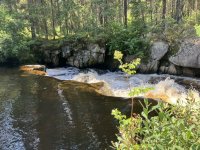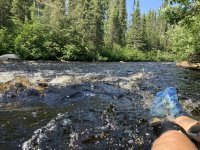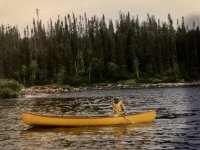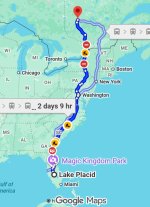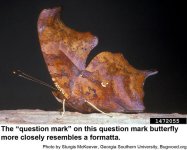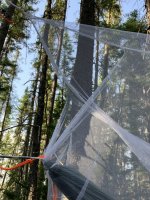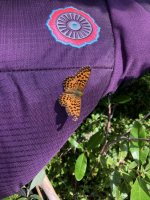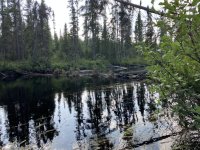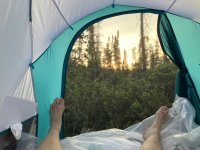2025 - The Day After
The night I was dropped off by the side of the tracks was so horrible I have been unable to write about it. It didn't rain and I didn't get attacked by a bear, but everything else seemingly went wrong; it was confusing and exhausting to an extent I've never before felt. So, let’s move on to the next morning and come back to the first night at some later date.
As my brain returned to consciousness, my first thought was *What happened to the tent?* Then, "Why do my shoulder and hip hurt so much?" And finally I remembered half my gear and the canoe were still on the top of the embackment. I had managed to get everything far enough off the tracks to feel "safe." I wanted to hide from it all, but there is no place to hide when alone in the wilderness.
First on the agenda was getting the canoe and the rest of the gear down off the embankment. This was much more difficult than it sounded. I was worried I would damage the canoe before I even got on the water.
Next was finding a decent place to camp. Still thinking I would find signs of others' camps, I looked around to no avail.
I felt so depleted I knew I had to stay in this area another night. The forest was like a jungle. It was almost impossible to walk through it. Vines laced bushes and trees in the moss covered ground. Deep, clotted mosses covered everything, hiding the pitfalls below. If there was a level square foot along the water, I didn't find it. I did find a sort of somewhat level spot; with four trees reasonably spaced so a tent could be erected. It was uneven, lumpy, not level, but I could live with it.
I walked back to the base of the embankment, picked up the tent (easily found about 20 feet away in the morning) under one arm and picked up a pack with the other walked about five steps and put the pack down. I had to have at least one hand free to balance and negotiate the trees and branches. I walked back to where I found the sort of ok space and found nothing. I had not marked it and I had no idea how much this part of the forest resembled that part of the forest. I remembered it was back a short ways off the water. After much searching I gave up and sat in a very small clearing, probably the result of beaver or muskrat use. This little patch of bare ground could be my kitchen.
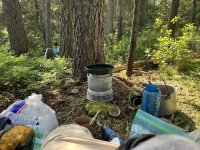
And I found a couple of reasonably spaced trees and set up a hammock and a mesh tent. I had brought these along for two reasons. I could use it if I couldn't find a place for the tent and it's nice to have a place to hang out - pardon the pun - when I just want a short rest. I brought the mesh tent because the bug netting sold for hammocks gives me claustrophobia.
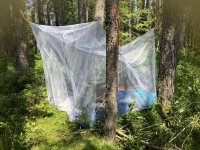
I could not figure out how to erect the mesh canopy higher than the hammock. After pondering this for a while, I just ripped it out. Later, I patched the rip with heavy duty Velcro tape. This looked good, but there was not enough surface area on the mesh to hold the sticky tape part. I used large safety pins to try to patch that up. It was far from perfect, but was good enough.
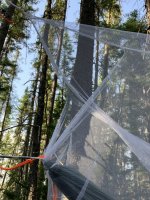

I spent the remainder of that day resting. Nap in the hammock. A refreshing dip in the water. A hideous toad. When I first noticed it, I could not decide if it was a leaf, a flying squirrel, a rock or a toad. It has claws. Google assures me that toads never have claws, but some toads extent their toes so far, they look like claws. I thought it looked like something out of the Mines of Moria. One of the hangers-on of the Balrog perhaps.
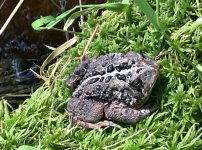
When I woke from a well-deserved nap, I greatly enjoyed hanging in the forest, looking at what clouds and blue sky peaked through the trees. A couple of butterflies were trapped in the mesh.
The next few paragraphs are about the butterflies and I have lumped them together here so if your interest flags, you can just skip forward. Each butterfly is so unlike the *Very Hungry Caterpillar* that it's worth taking a closer look.
The first is a fritillary butterfly, probably the Arctic Fritillary (*Boloria chariclea*), which flies in July and August in the north.

The caterpillars take one to two years to "grow up" during which time they eat violets willow and blueberry leaves. The adults, which live only one to two weeks, feed on the nectar of goldenrod and asters, which were plentiful along the water edges. The wings become battered and torn, some wear and tear and a bite from an unsuccessful bird. One or two of these butterflies decorated the landscape while I was camped in this area. I never saw them again.
The second butterfly is a Question Mark Butterfly (*Polygonia interrogationis*), named for a very tiny silver mark on the underside of its angular wings.
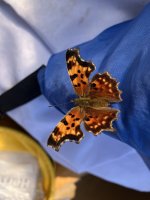
The deep slashes that separate the upper from lower wings in this case are the actual design of the butterfly and not caused by a bird beak. This actual photo was taken at the end of the trip where the butterfly wings were perfectly shaped, the butterfly dust was fresh and velvety and the reflective sheen was vibrant. In contrast, the underside of the wing is camoflaged and when closed resembles a dry leaf as seen in this photo (not mine)
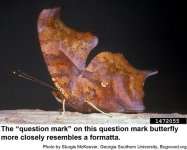
You can also note the white question mark (silver in sunlight and yeah, it doesn't look like a question mark to me either.)
Question Marks are migratory and probably two flights arrive in Quebec in the summer months. The females lay their eggs any old place and trust their offspring will find the correct plants to eat, which include Hackberry, Elm, nettles and false nettles. They are typically found in woodlands and near streams and marshes. Question Mark adults feed on dead, decaying animals, rotton fruit and tree sap. If they are really desperate they may also take flower nectar.
The rarest butterfly in Canada is the Karner Blue. I mention this because I have loved Blues since I was a child on my knees, nose to the grass, watching the tiny blue butterflies in the lawn. The Karner Blue caterpillars eat only lupine leaves and habitat loss is believed to be the culprit in their decline. The males are the most colorful, having bright orange spots lining the edges of the lower wings, but I have always preferred the pure blue of the females.
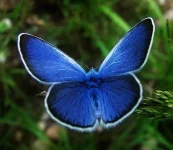
It was taking me longer to recuperate from my exertions the night of my arrival, so I decided to stay here another day. To be honest, except for the black flies and one or two trains a day, this was a delightful place. There was deep running water. Rocks. Flowers. Once one got off the tracks: no evidence that anyone had ever been here before.

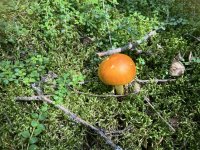
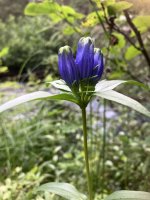
So I slept late yet again. I wandered around, back up to the tracks to see if I could find any other paths in the area. I went over the bridge and around back the other way, but saw nothing. Halfway down the embankment there was an old pole with antique glass insulators which I believe are now quite valuable. I considered trying to remove them and pack them out, but this seemed much too difficult and I had no interest in toting more weight.
Speaking of weight, I had to get the canoe from the base of the embankment to the still water at the base of the rapids. There was no way to carry the boat on my shoulders; there was hardly anyway for me to get through the trees, bushes and vines.
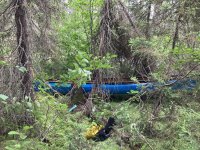
My confidence had been spooked by my initial difficulties. I was afraid I couldn't make the turns, do the ferries, etc. This was pretty silly because it was a narrow bit of water and it burbled along merrily, but was hardly life threatening.
The way down was fast and fun. The maneuvering was minimal; the water did most of the work. Passed my chosen put-in location, and so had to turn around and paddle back up. Getting out was going to be a problem. The Colden Dragonfly does not handle well empty; the water was deep. The spot was narrow. In attempting to exit the boat, it heeled way to port side and I jumped out sliding into the water. I managed to keep the boat upright, but I was dripping wet.

It only took me a few minutes to realize that once I was wet, I might as well get over to river right, where a large rock sat in a sunny spot. I walked the boat across and landed on the rock. A delightful spot. I dried out on the rock, realizing I'd have to get wet all over again, but I really didn't mind. The weather was warm and sunny and truth be told, I don't like getting wet, but once I am wet, I enjoy it immensely.
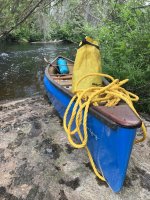
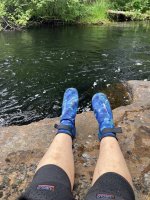
I entertained myself examing the miniature forests of mosses and tiny vascular plants springing out of the cracks in the rock.


I thoroughly enjoyed this day, in the woods, in the water and sleeping in the hammock with the stars above. Of course, I couldn't see the stars because the trees were so thick, but I could imagine them up there. I had regained my composure and I had a plan. Tomorrow, rested, I would load up my gear and get this trip going.
Of course, it wasn't that easy. Tomorrow brought a whole new set of problems.

